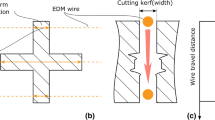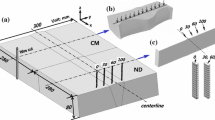Abstract
The contour method is applied in an innovative manner to measure the distribution of hoop residual stress in a large martensitic-ferritic steel pipe containing a multi-pass girth weld. First, a novel one-step wire electro-discharge machining cut is conducted to divide the pipe lengthways into two halves. The deformation of the cut halves is then measured and analysed in a way that simultaneously gives maps of hoop stress across the wall thickness on both sides of the pipe and automatically accounts for through-thickness hoop bending effects and how they may vary along the pipe. Finally the contour method results are combined with X-ray diffraction residual stress measurements using the principle of superposition to determine the distribution of the axial and radial residual stresses in the pipe. It is thereby demonstrated how the distribution of three direct components of the residual stress tensor in a welded pipe can be readily determined using a “hybrid” contour measurement approach.















Similar content being viewed by others

References
R6 Revision 4, Assessment of the Integrity of Structures Containing Defects, Including Amendments to 2010, Gloucester, UK: British Energy Generation Ltd (2001).
API 579/ASME FFS-1, Fitness-for-Service, Second edition, Washington DC: American Society of Mechanical Engineers (2007).
BS7910:2005, Guide to Methods for Assessing the Acceptability of Flaws in Metallic Structures, Incorporating Amendment No.1. London: Bsi (2007).
Francis JA, Mazur W, Bhadeshia HKDH (2006) Type IV Cracking in Ferritic Power Plant Steels. J Mater Sci Technol 22(12):1387–1395
Yaghi AH, Hyde TH, Becker AA, Sun W, Hilson G, Simandjuntak S, Flewitt PEJ, Pavier MJ, Smith DJ (2010) A comparison between measured and modeled residual stresses in a circumferentially butt-welded P91 steel pipe. J Pressure Vessel Technol 132:1–10
Withers PJ, Bhadeshia KDH (2001) Residual stress: part 1-measurement techniques. J Mater Sci Technol 17:355–365
Smith DJ, Bouchard PJ, George D (2000) Measurement and prediction of residual stresses in thick-section steel welds. J Strain Anal Eng Des 35(4):287–305
Withers PJ, Turski M, Edwards L, Bouchard PJ, Buttle DJ (2008) Recent advances in residual stress measurement. Int J Press Vessels Pip 85:118–127
Bouchard PJ, George D, Santisteban JR, Bruno G, Dutta M, Edwards L, Kingston EJ, Smith DJ (2005) Measurement of residual stress in a stainless steel pipe girth weld containing long and short repairs. Int J Press Vessels Pip 82(4):299–310
Edwards L, Bouchard PJ, Dutta M, Wang DQ, Santisteban JR, Hiller S, Fitzpatrick ME (2005) Direct measurement of residual stresses near a “Boat-shaped” repair in a 20 mm thick stainless steel tube butt weld. Int J Press Vessels Pip 82:288–298
Prime MB (2001) Cross-sectional mapping of residual stresses by measuring the surface contour after a cut. J Eng Mater Technol 123(2):162–168
DeWald AT, Rankin JE, Hill MR, Lee MJ, Chen HL (2004) Assessment of tensile residual stress mitigation in alloy 22 welds due to laser peening. J Eng Mater Technol 126:465–473
DeWald A, Hill MR (2009) Eigenstrain-based model for prediction of laser peening residual stresses in arbitrary three-dimensional bodies, part 2: model verification. J Strain Anal Eng Des 44(1):13–27
Zhang Y, Ganguly S, Edwards L, Fitzpatrick ME (2004) Cross-sectional mapping of residual stresses in a VPPA welde using the contour method. Acta Mater 52:5225–5232
Zhang Y, Ganguly S, Stelmukh V, Fitzpatrick ME, Edwards L (2003) Validation of the contour method of residual stress measurement in a MIG 2024Weld by neutron and synchrotron x-ray diffraction. J Neutron Res 11(4):181–185
Hosseinzadeh F, Toparli MB, Bouchard PJ (2012) Slitting and contour method residual stress measurements in an edge welded beam. J Pressure Vessel Technol 134(1)
Woo W, Choo H, Prime MB, Feng Z, Clausen B (2008) Microstructure, texture and residual stress in a friction-stir-processed AZ31B magnesium alloy. Acta Mater 56(8):1701–1711
Prime MB, Gnaupel-Herold T, Baumann JA, Lederich RJ, Bowden DM, Sebring RJ (2006) Residual stress measurements in a thick dissimilar alluminium alloy friction stir weld. Acta Mater 54:4013–4021
Mahmoudi AH, Hossain S, Pavier MJ, Truman CE, Smith DJ (2009) A new procedure to measure near yield residual stresses using the deep hole drilling technique. Exp Mech 49(4):595–604
Prime MB (2010) Plasticity effect in incremental slitting measurement of residual stresses. Eng Fract Mech 77:1552-1515-1566
Prime MB, Kastengren AL (2010) The contour method cutting assumption: error minimization and correction. In: SEM Annual Conference, Indianapolis, Indiana, 7–10 June 2010.
Traore Y, Bouchard PJ, Francis JA, Hosseinzadeh F (2011) A Novel Cutting Strategy for Reducing Plasticity Induced Errors in Residual Stress Measurements Made with the Contour Method. Paper presented at the American Society of Mechanical Engineers, Pressure Vessels and Piping Division (Publication) PVP, Proceedings of the ASME Pressure Vessels and Piping Conference - Materials and Fabrication, Baltimore, USA
Prime MB (2011) Contour method advanced applications: hoop stresses in cylinders and discontinuities. In: Proulx T (ed) Engineering Application of Residual Stress, The Society for Experimental Mechanics. pp 13–28
Johnson G (2008) Residual stress measurements using the contour method. University of Manchester, Manchester
Pagliaro P, Prime MB, Robinson JS, Clausen B, Swenson H, Steinzig M, Zuccarello B (2010) Meausring inaccessible residual streses using multiple methods and superposition. Exp Mech 51(7):1123–1134
Bueckner HF (1973) Field singularities and related integral representations. In: Sih GC (ed) Mechanics of Fracture. pp 239–314
Prime MB (2009) The contour method: a new approach in experimental mechanics. Proceedings of the SEM Annual Conference. Albuquerque, NM, USA
Prime MB, Sebring RJ, Edwards JM, Hughes DJ, Webster PJ (2004) Laser surface-contouring and spline data-smoothing for residual stress measurement. Exp Mech 44(2):176–184
Haarmann K, Vaillant JC, Vandenberghe B, Bendick W, Arab A (2002) The T91/P91 book, vallourec & mannesmann tubes
Spaddea S, Francis JA, Paradowska AM, Bouchard PJ, Shibli IA (2012) Residual stress distributions in a P91 steel-pipe girth weld before and after post weld heat treatment. Mater Sci Eng, A 534:663–672
Fitzpatrick ME, Fry AT, Holdway P, Kandil FA, Shackleton J, Suominen L (2005) Determination of residual stress by x-ray diffraction-issue 2. A National Measurement Good Practice Guide, No 52
Noyan IC, Cohen JB (1987) Residual stress measurement by diffraction and interpretation. Springer, New York
ABAQUS (2010) ABAQUS/Standard Documentation Version 6.10.2, ABAQUS Inc.
Acknowledgments
The authors would like to acknowledge the contribution of staff at The Open University staff including Peter Ledgard and Stan Hiller who instrumented and conducted the contour cut. P J Bouchard acknowledges support of a Royal Society Industry Fellowship. The research was supported by funding from the East Midlands Development Agency and Rolls-Royce Power Engineering Ltd.
Author information
Authors and Affiliations
Corresponding author
Rights and permissions
About this article
Cite this article
Hosseinzadeh, F., Bouchard, P.J. Mapping Multiple Components of the Residual Stress Tensor in a Large P91 Steel Pipe Girth Weld Using a Single Contour Cut. Exp Mech 53, 171–181 (2013). https://doi.org/10.1007/s11340-012-9627-z
Received:
Accepted:
Published:
Issue Date:
DOI: https://doi.org/10.1007/s11340-012-9627-z



